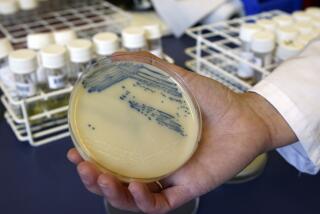Sufferers of Acne, Beware: Pimples May Be Winning
Antibiotics have long been a favorite remedy to treat acne. Adults and adolescents with even mild outbreaks are sometimes treated with tetracycline or erythromycin to quickly clear blemishes.
But doctors may be forced to become stingier with antibiotics. Several recent studies show that acne-causing bacteria, Propionibacterium acnes--or P. acnes--have developed strains that resist both topical and oral antibiotics.
This turn of events is not good news for the 17 million Americans who battle acne.
“By the year 2000, dermatologists worldwide may have few, if any, antimicrobial agents to rely on to treat their acne patients,” Dr. William J. Cunliffe told dermatologists earlier this year at a national meeting. Cunliffe, of the University of Leeds in England, has conducted several studies on acne drugs.
Antibiotic resistance is a major health threat, not just with acne. Generally, the problem is most threatening in hospital settings, where people are very sick with immune-weakening diseases and are more likely to be exposed to resistant strains. In these circumstances, antibiotic resistance can even be a factor in death.
By comparison, antibiotic resistance to acne may seem to be a minor problem. But acne can devastate the complexions and self-esteem of adolescents and adults and can leave scarring if left untreated, according to a recent study sponsored by the Neutrogena Corp. Psychologist Thomas F. Cash, of Old Dominion University, found that 42% of adult women who had severe acne in the past continued to have a negative body image.
“Antibiotic resistance is a problem other areas of medicine have seen. We are just not used to seeing it in acne,” says Dr. Gary White, an assistant clinical professor at UC San Diego.
Oral antibiotics work quickly to suppress the growth of the bacteria and reduce the inflammation. The medications are typically taken for several months.
But, according to Dr. James Leyden, an authority on acne from the University of Pennsylvania, one out of four acne patients has some strains of P. acnes that are resistant to tetracycline, erythromycin and clindamycin--all mainstay antibiotics that have been highly effective for treating acne.
If a patient has a high number of resistant strains, the antibiotic treatment may fail.
“There are significant resistance rates such to the point that erythromycin has become less and less useful because it doesn’t have the effect it once did,” White says.
Studies also show that some strains are resistant to tetracycline and doxycycline, he says. Moreover, some resistance may be cropping up against minocycline, the current favorite among doctors.
Some dermatologists say antibiotic resistance is not a big problem--yet.
“I haven’t seen a problem [with resistance] in our office yet,” says Dr. Lenore S. Kakita, an assistant clinical professor at UCLA School of Medicine. “But acne is multifaceted, so it is hard to say ‘this antibiotic is working’ because of the other factors.”
For example, she says, other treatments may be prescribed in addition to an antibiotic, making it difficult to know which was most successful. And sometimes the cause of the acne outbreak disappears. Patients can improve without really knowing why, Kakita says.
Resistance is thought to have developed because patients don’t finish taking the entire prescribed dose, thus allowing the strongest bacteria to survive. It can also be caused by very long courses of antibiotics or the use of two or more antibiotics together or in quick succession.
One strategy for dealing with resistance is for doctors to avoid using antibiotics unless absolutely necessary, such as when pustules form. For people with mild or moderate acne, doctors may first try topical remedies such as Retin-A or benzoyl peroxide.
“I try using the other things first--topical things. And we’re getting better results with them because there are more choices,” Kakita says. “Before we had patients on antibiotics all the time. Now, many patients can be controlled with topicals.”
Moreover, the first new prescription drug for mild to moderate acne was introduced last month by the Irvine-based company Allergan. The drug, Azelex, is a topical cream that is chemically different from other acne medications. It was designed primarily for adult women, although many dermatologists use it on teens too.
The drug is an azelaic acid cream made of a naturally occurring substance found in wheat. It’s mild and helps remove the red-colored lesion that subsists after the pimple clears up, Kakita says.
“Azelex does take a couple of months to start working, so I start it in combination with something else,” such as Retin-A or glycolic acids, she says. “The nice thing about Azelex is, it can get that color scar to clear up.”
If antibiotics are clearly needed, doctors should treat patients for the shortest time possible and should reuse the same antibiotic whenever possible, experts say.
There are other drawbacks to antibiotics in addition to resistance. Some, such as erythromycin, can cause an upset stomach. And tetracycline causes photosensitivity, which can be a factor in severe sunburn if care is not taken.
For that reason, Kakita says, “In Southern California, it’s better if we don’t have to use antibiotics.”






